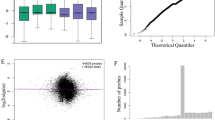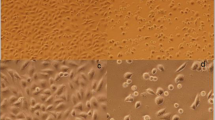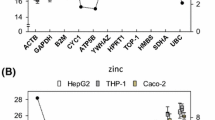Abstract
Chromium (Cr) is a trace element required for life. Biological activities of Cr are complicated and remain to be fully investigated. It is known that the valence of Cr plays an important role in the biological activities of Cr. For example, Cr (VI) is classified as a metal carcinogen [1], but Cr (III) is widely used as a nutritional supplement [2, 3]. Establishment of a gene expression profile for Cr-induced cellular response is necessary to facilitate investigation of the biological activities of Cr. In the present study, a large-scale gene expression analysis was conducted using RNA of human lung epithelial cells after in vitro exposure to Cr (VI). Utilizing high-density oligonucleotide arrays representing 2400 genes, we observed that expression of 150 genes was up-regulated, and that of 70 genes were down-regulated by Cr (VI). Functional analysis of these responsive genes led to an outline of potential biological activities of Cr in six aspects. The gene expression profile reveals that Cr may involves in redox stress, calcium mobilization, energy metabolism, protein synthesis, cell cycle regulation and carcinogenesis in the cell. The results provide a critical clue for understanding molecular mechanisms of the biological activities of Cr.
Similar content being viewed by others
References
Shi X, Chiu A, Chen CT, Halliwell B, Castranova V, Vallyathan V: Reduction of chromium (VI) and its relationship to carcinogenesis. J Toxicol Environ Health, Part B, Crit Rev 2: 87–104, 1999
Anderson RA: Chromium as an essential nutrient for humans. Reg Toxicol Pharmacol 26: S35–S41, 1997
Jeejeebhoy KN: The role of chromium in nutrition and therapeutics and as a potential toxin. Nutr Rev 57: 329–335, 1999
Ye J, Wang S, Leonard SS, Sun Y, Butterworth L, Antonini J, Ding M, Rojanasakul Y, Vallyathan V, Castranova V, Shi X: Role of reactive oxygen species and p53 in chromium (VI)-induced apoptosis. J Biol Chem 274: 34974–34980, 1999
Ye J, Zhang X, Young HA, Mao Y, Shi X: Chromium (VI)-induced nuclear factor-kappa B activation in intact cells via free radical reactions. Carcinogenesis 16: 2401–2405, 1995
Anderson RA: Chromium in the prevention and control of diabetes. Diabetes Metab 26: 22–27, 2000
Kozal MJ, Shah N, Shen N, Yang R, Fucini R, Merigan TC, Richman DD, Morris D, Hubbell E, Chee M, Gingeras TR: Extensive polymorphisms observed in HIV-1 clade B protease gene using high-density oligonucleotide arrays. Nature Med 2: 753–759, 1996
Lee CK, Klopp RG, Weindruch R, Prolla TA: Gene expression profile of aging and its retardation by caloric restriction. Science 285: 1390–1393, 1999
Friedman J, Shabtai F, Levy LS, Djaldetti M: Chromium chloride induces chromosomal aberrations in human lymphocytes via indirect action. Mutat Res 191: 207–210, 1987
Orr WC, Sohal RS: Extension of life-span by overexpression of superoxide dismutase and catalase in Drosophila melanogaster. Science 263: 1128–1130, 1994
Andrews GK: Regulation of metallothionein gene expression. Prog Food Nutr Sci 14: 193–258, 1990
Radtke F, Heuchel R, Georgiev O, Hergersberg M, Gariglio M, Dembic Z, Schaffner W: Cloned transcription factor MTF-1 activates the mouse metallothionein I promoter. Embo J 12: 1355–1362, 1993
Thoma F: Light and dark in chromatin repair: Repair of UV-induced DNA lesions by photolyase and nucleotide excision repair. Embo J 18: 6585–6598, 1999
Todo T, Ryo H, Yamamoto K, Toh H, Inui T, Ayaki H, Nomura T, Ikenaga M: Similarity among the Drosophila (6-4) photolyase, a human photolyase homolog, and the DNA photolyase-blue-light photoreceptor family. Science 272: 109–112, 1996
Shimada H, Shiao YH, Shibata M, Waalkes MP: Cadmium suppresses apoptosis induced by chromium. J Toxicol Environ Health 54: 159–168, 1998
Singh J, Carlisle DL, Pritchard DE, Patierno SR: Chromium-induced genotoxicity and apoptosis: Relationship to chromium carcinogenesis. Oncol Rep 5: 1307–1318 (review), 1998
Bagchi D, Joshi SS, Bagchi M, Balmoori J, Benner EJ, Kuszynski CA, Stohs SJ: Cadmium-and chromium-induced oxidative stress, DNA damage, and apoptotic cell death in cultured human chronic myelogenous leukemic K562 cells, promyelocytic leukemic HL-60 cells, and normal human peripheral blood mononuclear cells. J Biochem Mol Toxicol 14: 33–41, 2000
Carlisle DL, Pritchard DE, Singh J, Patierno SR: Chromium (VI) induces p53-dependent apoptosis in diploid human lung and mouse dermal fibroblasts. Mol Carcinogen 28: 111–118, 2000
Blankenship LJ, Manning FC, Orenstein JM, Patierno SR: Apoptosis is the mode of cell death caused by carcinogenic chromium. Toxicol Appl Pharmacol 126: 75–83, 1994
Nemani M, Linares-Cruz G, Bruzzoni-Giovanelli H, Roperch JP, Tuynder M, Bougueleret L, Cherif D, Medhioub M, Pasturaud P, Alvaro V, der Sarkissan H, Cazes L, Le Paslier D, Le Gall I, Israeli D, Dausset J, Sigaux F, Chumakov I, Oren M, Calvo F, Amson RB, Cohen D, Telerman A: Activation of the human homologue of the Drosophila sina gene in apoptosis and tumor suppression. Proc Nat Acad Sci USA 93: 9039–9042, 1996
Matsuzawa S, Takayama S, Froesch BA, Zapata JM, Reed JC: p53-inducible human homologue of Drosophila seven in absentia (Siah) inhibits cell growth: Suppression by BAG-1. Embo J 17: 2736–2747, 1998
Schulte TW, Akinaga S, Murakata T, Agatsuma T, Sugimoto S, Nakano H, Lee YS, Simen BB, Argon Y, Felts S, Toft DO, Neckers LM, Sharma SV: Interaction of radicicol with members of the heat shock protein 90 family of molecular chaperones. Mol Endocrinol 13: 1435–1448, 1999
Chen CF, Chen Y, Dai K, Chen PL, Riley DJ, Lee WH: A new member of the hsp90 family of molecular chaperones interacts with the retinoblastoma protein during mitosis and after heat shock. Mol Cell Biol 16: 4691–4699, 1996
Hai T, Wolfgang CD, Marsee DK, Allen AE, Sivaprasad U: ATF3 and stress responses. Gene Exp 7: 321–335, 1999
Guerini D, Klee CB: Cloning of human calcineurin A: Evidence for two isozymes and identification of a polyproline structural domain. Proc Natl Acad Sci USA 86: 9183–9187, 1989
Haendler B, Hofer-Warbinek R, Hofer E: Complementary DNA for human T-cell cyclophilin. Embo J 6: 947–950, 1987
Liu J, Albers MW, Wandless TJ, Luan S, Alberg DG, Belshaw PJ, Cohen P, MacKintosh C, Klee CB, Schreiber SL: Inhibition of T cell signaling by immunophilin-ligand complexes correlates with loss of calcineurin phosphatase activity. Biochemistry 31: 3896–3901, 1992
Hu Z, Bonifas JM, Beech J, Bench G, Shigihara T, Ogawa H, Ikeda S, Mauro T, Epstein EH Jr: Mutations in ATP2C1, encoding a calcium pump, cause Hailey-Hailey disease. Nat Genet 24: 61–65, 2000
Bouchard C, Despres JP, Tremblay A: Genetics of obesity and human energy metabolism. Proc Nutr Soc 50: 139–147, 1991
Boulanger BR, Milzman DP, Rodriguez A: Obesity. Crit Care Clin 10: 613–622, 1994
Zhang Y, Proenca R, Maffei M, Barone M, Leopold L, Friedman JM: Positional cloning of the mouse obese gene and its human homologue. Nature 372: 425–432, 1994
Gong DW, Bi S, Pratley RE, Weintraub BD: Genomic structure and promoter analysis of the human obese gene. J Biol Chem 271: 3971–3974, 1996
Kelly DP, Kim JJ, Billadello JJ, Hainline BE, Chu TW, Strauss AW: Nucleotide sequence of medium-chain acyl-CoA dehydrogenase mRNA and its expression in enzyme-deficient human tissue. Proc Natl Acad Sci USA 84: 4068–4072, 1987
Ptasznik A, Gewirtz AM: Crosstalk between G protein-coupled receptors and tyrosine kinase signaling: Src take centre stage. Arch Immunol Ther Exp 48: 27–30, 2000
Diverse-Pierluissi M, Remmers AE, Neubig RR, Dunlap K: Novel form of crosstalk between G protein and tyrosine kinase pathways. Proc Nat Acad Sci USA 94: 5417–5421, 1997
Gianfrancesco F, Esposito T, Montanini L, Ciccodicola A, Mumm S, Mazzarella R, Rao E, Giglio S, Rappold G, Forabosco A: A novel pseudoautosomal gene encoding a putative GTP-binding protein resides in the vicinity of the Xp/Yp telomere. Hum Mol Genet 7: 407–414, 1998
Partanen J, Armstrong E, Bergman M, Makela TP, Hirvonen H, Huebner K, Alitalo K: cyl encodes a putative cytoplasmic tyrosine kinase lacking the conserved tyrosine autophosphorylation site (Y416src). Oncogene 6: 2013–2018, 1991
Sakano S, Iwama A, Inazawa J, Ariyama T, Ohno M, Suda T: Molecular cloning of a novel non-receptor tyrosine kinase, HYL (hematopoietic consensus tyrosine-lacking kinase). Oncogene 9: 1155–1161, 1994
Livi GP, Kmetz P, McHale MM, Cieslinski LB, Sathe GM, Taylor DP, Davis RL, Torphy TJ, Balcarek JM: Cloning and expression of cDNA for a human low-Km, rolipram-sensitive cyclic AMP phosphodiesterase. Mol Cell Biol 10: 2678–2686, 1990
Winzen R, Kracht M, Ritter B, Wilhelm A, Chen CY, Shyu AB, Muller M, Gaestel M, Resch K, Holtmann H: The p38 MAP kinase pathway signals for cytokine-induced mRNA stabilization via MAP kinase-activated protein kinase 2 and an AU-rich region-targeted mechanism. Embo J 18: 4969–4980, 1999
Uddin S, Majchrzak B, Woodson J, Arunkumar P, Alsayed Y, Pine R, Young PR, Fish EN, Platanias LC: Activation of the p38 mitogen-activated protein kinase by type I interferons. J Biol Chem 274: 30127–30131, 1999
Fisher EM, Beer-Romero P, Brown LG, Ridley A, McNeil JA, Lawrence JB, Willard HF, Bieber FR, Page DC: Homologous ribosomal protein genes on the human X and Y chromosomes: Escape from X inactivation and possible implications for Turner syndrome. Cell 63: 1205–1218, 1990
Si K, Das K, Maitra U: Characterization of multiple mRNAs that encode mammalian translation initiation factor 5 (eIF-5). J Biol Chem 271: 16934–16938, 1996
Cruzen ME, Arfin SM: Nucleotide and deduced amino acid sequence of human threonyl-tRNA synthetase reveals extensive homology to the Escherichia coli and yeast enzymes. J Biol Chem 266: 9919–9923, 1991
Ishii T, Itoh K, Sato H, Bannai S: Oxidative stress-inducible proteins in macrophages. Free Rad Res 31: 351–355, 1999
Pancre V, Pierce RJ, Fournier F, Mehtali M, Delanoye A, Capron A, Auriault C: Effect of ubiquitin on platelet functions: Possible identity with platelet activity suppressive lymphokine (PASL). Eur J Immunol 21: 2735–2741, 1991
Toth MJ, Huwyler L: Molecular cloning and expression of the cDNAs encoding human and yeast mevalonate pyrophosphate decarboxylase. J Biol Chem 271: 7895–7898, 1996
Guan KL, Jenkins CW, Li Y, O'Keefe CL, Noh S, Wu X, Zariwala M, Matera AG, Xiong Y: Isolation and characterization of p19INK4d, a p16-related inhibitor specific to CDK6 and CDK4. Mol Biol Cell 7: 57–70, 1996
Hirai H, Roussel MF, Kato JY, Ashmun RA, Sherr CJ: Novel INK4 proteins, p19 and p18, are specific inhibitors of the cyclin D-dependent kinases CDK4 and CDK6. Mol Cell Biol 15: 2672–2681, 1995
Fattaey AR, Helin K, Dembski MS, Dyson N, Harlow E, Vuocolo GA, Hanobik MG, Haskell KM, Oliff A, Defeo-Jones D, Jones ARE: Characterization of the retinoblastoma binding proteins RBP1 and RBP2. Oncogene 8: 3149–3156, 1993
Vogt T, Kroiss M, McClelland M, Gruss C, Becker B, Bosserhoff AK, Rumpler G, Bogenrieder T, Landthaler M, Stolz W: Deficiency of a novel retinoblastoma binding protein 2-homolog is a consistent feature of sporadic human melanoma skin cancer. Lab Invest 79: 1615–1627, 1999
Galaktionov K, Lee AK, Eckstein J, Draetta G, Meckler J, Loda M, Beach D: CDC25 phosphatases as potential human oncogenes. Science 269: 1575–1577, 1995
Lammer C, Wagerer S, Saffrich R, Mertens D, Ansorge W, Hoffmann I: The cdc25B phosphatase is essential for the G2/M phase transition in human cells. J Cell Sci 111: 2445–2453, 1998
Forrest AR, McCormack AK, DeSouza CP, Sinnamon JM, Tonks ID, Hayward NK, Ellem KA, Gabrielli BG: Multiple splicing variants of cdc25B regulate G2/M progression. Biochem Biophys Res Commun 260: 510–515, 1999
Kiyono T, Fujita M, Hayashi Y, Ishibashi M: Cloning of a cDNA encoding a human homologue of CDC47, a member of the MCM family. Biochim Biophys Acta 1307: 31–34, 1996
Fujita M, Kiyono T, Hayashi Y, Ishibashi M: hCDC47, a human member of the MCM family. Dissociation of the nucleus-bound form during S phase. J Biol Chem 271: 4349–4354, 1996
Meisner H, Heller-Harrison R, Buxton J, Czech MP: Molecular cloning of the human casein kinase II alpha subunit. Biochemistry 28: 4072–4076, 1989
Stohs SJ, Bagchi D: Oxidative mechanisms in the toxicity of metal ions. Free Rad Biol Med 18: 321–336, 1995
Hoyal CR, Giron-Calle J, Forman HJ: The alveolar macrophage as a model of calcium signaling in oxidative stress. J Toxicol Environ Health. Part B, Crit Rev 1: 117–134, 1998
Vallyathan V, Shi X: The role of oxygen free radicals in occupational and environmental lung diseases. Environ Health Persp 105(suppl 1): 165–177, 1997
Buzard GS, Kasprzak KS: Possible roles of nitric oxide and redox cell signaling in metal-induced toxicity and carcinogenesis: A review. J Environ Pathol Toxicol Oncol 19: 179–199, 2000
Stadtman ER, Berlett BS: Reactive oxygen-mediated protein oxidation in aging and disease. Drug Metab Rev 30: 225–243, 1998
Anderson RA: Effects of chromium on body composition and weight loss. Nutr Rev 56: 266–270, 1998
Xu J, Bubley GJ, Detrick B, Blankenship LJ, Patierno SR: Chromium (VI) treatment of normal human lung cells results in guanine-specific DNA polymerase arrest, DNA-DNA cross-links and S-phase blockade of cell cycle. Carcinogenesis 17: 1511–1517, 1996
Author information
Authors and Affiliations
Rights and permissions
About this article
Cite this article
Ye, J., Shi, X. Gene expression profile in response to chromium-induced cell stress in A549 cells. Mol Cell Biochem 222, 189–197 (2001). https://doi.org/10.1023/A:1017974415052
Issue Date:
DOI: https://doi.org/10.1023/A:1017974415052




